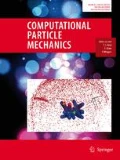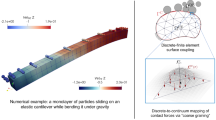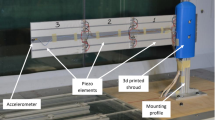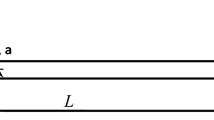Abstract
The discrete element method (DEM) is a general discrete modeling technique traditionally used to model granular material and discontinuous phenomena such as fracture and fragmentation of solids. We investigate the efficacy of DEM to model deformable elastic continua, cantilever beams in particular, and describe their mechanical behavior under loading. Of distinct interest is the ability of DEM to capture geometric nonlinearity in their large-displacement response. A case study is presented to demonstrate the utility of this approach in particle–structure problems that involve large structural displacements. We simulated an array of these cantilever beams in large elastic oscillations amidst a particulate environment, modeled using DEM. Mobile particles encounter the deflecting beams in their paths and can be redirected for capture based on net forces and moments that act on them. The dynamics of the ensuing particle–structure interactions is simulated, and factors regulating the efficiency of particle capture are examined.















Similar content being viewed by others
Availability of data and material
Modeling data may be requested from the authors.
References
Zhou EH, Martinez FD, Fredberg JJ (2013) Cell rheology: mush rather than machine. Nat Mater 12(3):184–185
Braun T, Ghatkesar MK, Backmann N, Grange W, Boulanger P, Letellier L, Lang H-P, Bietsch A, Gerber C, Hegner M (2009) Quantitative time-resolved measurement of membrane protein–ligand interactions using microcantilever array sensors. Nat Nanotechnol 4(3):179
Sitti M (2004) Atomic force microscope probe based controlled pushing for nanotribological characterization. IEEE/ASME Trans Mechatron 9(2):343–349
Wendeler C, Volkwein A, Roth A, Denk M, Wartmann S (2007) Field measurements and numerical modelling of flexible debris flow barriers. Debris-Flow Hazards Mitig Mech Predict Assess Millpress, Rotterdam, pp 681–687
Yang X, Liu M, Peng S, Huang C (2016) Numerical modeling of dam-break flow impacting on flexible structures using an improved SPH–EBG method. Coast Eng 108:56–64
Wu K, Yang D, Wright N, Khan A (2018) An integrated particle model for fluid–particle–structure interaction problems with free-surface flow and structural failure. J Fluids Struct 76:166–184
Tuhkuri J, Polojärvi A (2018) A review of discrete element simulation of ice–structure interaction. Philosoph Trans R Soc Math Phys Eng Sci 376(2129):20170335
Cundall PA, Strack OD (1979) A discrete numerical model for granular assemblies. Geotechnique 29(1):47–65
Cundall PA (1988) Formulation of a three-dimensional distinct element model—Part I. A scheme to detect and represent contacts in a system composed of many polyhedral blocks. Int J Rock Mech Min Sci Geomech Abstr, Pergamon, pp 107–116
Hart R, Cundall P, Lemos J (1988) Formulation of a three-dimensional distinct element model—Part II. Mechanical calculations for motion and interaction of a system composed of many polyhedral blocks. Int J Rock Mech Min Sci Geomech Abstr, Elsevier, pp 117–125
Munjiza AA, Knight EE, Rougier E (2011) Computational mechanics of discontinua. Wiley, New York
Munjiza A (2009) Special issue on the discrete element method: aspects of recent developments in computational mechanics of discontinua. Eng Comput 3:851
Potyondy DO, Cundall P (2004) A bonded-particle model for rock. Int J Rock Mech Min Sci 41(8):1329–1364
Tavarez FA, Plesha ME (2007) Discrete element method for modelling solid and particulate materials. Int J Numer Meth Eng 70(4):379–404
Weerasekara N, Powell M, Cleary P, Tavares LM, Evertsson M, Morrison R, Quist J, Carvalho R (2013) The contribution of DEM to the science of comminution. Powder Technol 248:3–24
Richards K, Bithell M, Dove M, Hodge R (2004) Discrete–element modelling: methods and applications in the environmental sciences. Philos Trans R Soc London Ser Math Phys Eng Sci 362(1822):1797–1816
Cundall PA (2001) A discontinuous future for numerical modelling in geomechanics? Proc Inst Civil Eng Geotech Eng 149(1):41–47
Xu Q, Ye J (2019) An adaptively coupled DEM–FEM algorithm for geometrical large deformation analysis of member structures. Comput Part Mech, pp 1–13
Qi N, Ye JH (2013) Geometric nonlinear analysis with large deformation of member structures by discrete element method. J Southeast Univ Nat Sci Ed 43(5):917–922
Guo Y, Wassgren C, Hancock B, Ketterhagen W, Curtis J (2013) Validation and time step determination of discrete element modeling of flexible fibers. Powder Technology 249:386–395
O’Sullivan C (2011) Particulate discrete element modelling: a geomechanics perspective. CRC Press, New York
Pöschel T, Schwager T (2005) Computational granular dynamics: models and algorithms. Springer, Berlin
Hertz H (1881) On the contact of elastic solids. Z Reine Angew Mathematik 92:156–171
Mindlin RD (1949) Compliance of elastic bodies in contact. J Appl Mech ASME 16:259–268
Mindlin RD (1953) Elastic spheres in contact under varying oblique forces. J Appl Mech 20:327–344
Johnson KL (1987) Contact mechanics. Cambridge University Press, Cambridge
Tsuji Y, Tanaka T, Ishida T (1992) Lagrangian numerical simulation of plug flow of cohesionless particles in a horizontal pipe. Powder Technol 71(3):239–250
Shen Z, Jiang M, Thornton C (2016) DEM simulation of bonded granular material. Part I: contact model and application to cemented sand. Comput Geotech 75:192–209
Kimball C, Tsai L-W (2002) Modeling of flexural beams subjected to arbitrary end loads. J Mech Des 124(2):223–235
Banerjee A, Bhattacharya B, Mallik A (2008) Large deflection of cantilever beams with geometric non-linearity: analytical and numerical approaches. Int J Non-Linear Mech 43(5):366–376
Zhang A, Chen G (2013) A comprehensive elliptic integral solution to the large deflection problems of thin beams in compliant mechanisms. J Mech Robot 5(2):337
Trahair NS (2005) Nonlinear elastic nonuniform torsion. J Struct Eng 131(7):1135–1142
Timoshenko SP, Gere JM (2009) Theory of elastic stability. Courier Corporation, London
Riisgård HU, Larsen PS (2001) Minireview: ciliary filter feeding and bio-fluid mechanics—present understanding and unsolved problems. Limnol Oceanogr 46(4):882–891
Ward JE (1996) Biodynamics of suspension-feeding in adult bivalve molluscs: particle capture, processing, and fate. Invert Biol 10:218–231
den Toonder JM, Onck PR (2013) Microfluidic manipulation with artificial/bioinspired cilia. Trends Biotechnol 31(2):85–91
Belardi J, Schorr N, Prucker O, Rühe J (2011) Artificial cilia: generation of magnetic actuators in microfluidic systems. Adv Funct Mater 21(17):3314–3320
Bhattacharya A, Buxton GA, Usta OB, Balazs AC (2012) Propulsion and trapping of microparticles by active cilia arrays. Langmuir 28(6):3217–3226
Whiting JG, Mayne R, Adamatzky A (2018) A parallel modular biomimetic cilia sorting platform. Biomimetics 3(2):5
Hanasoge S, Ballard M, Hesketh PJ, Alexeev A (2017) Asymmetric motion of magnetically actuated artificial cilia. Lab Chip 17(18):3138–3145
Hanasoge S, Hesketh PJ, Alexeev A (2018) Metachronal motion of artificial magnetic cilia. Soft Matter 14(19):3689–3693
Acknowledgements
Helpful discussions with the members of the Multidisciplinary and Multiscale Design and Device (M2D2) laboratory in the Mechanical Engineering Department at the Indian Institute of Science are gratefully acknowledged.
Funding
This project was funded in part by the Abdul Kalam Technology Innovation Fellowship to GKA.
Author information
Authors and Affiliations
Corresponding authors
Ethics declarations
Conflict of interest
None.
Code availability
Code may be requested from the authors.
Additional information
Publisher's Note
Springer Nature remains neutral with regard to jurisdictional claims in published maps and institutional affiliations.
Rights and permissions
About this article
Cite this article
Ghosh, P., Ananthasuresh, G.K. Discrete element modeling of cantilever beams subjected to geometric nonlinearity and particle–structure interaction. Comp. Part. Mech. 8, 637–651 (2021). https://doi.org/10.1007/s40571-020-00360-3
Received:
Revised:
Accepted:
Published:
Issue Date:
DOI: https://doi.org/10.1007/s40571-020-00360-3




